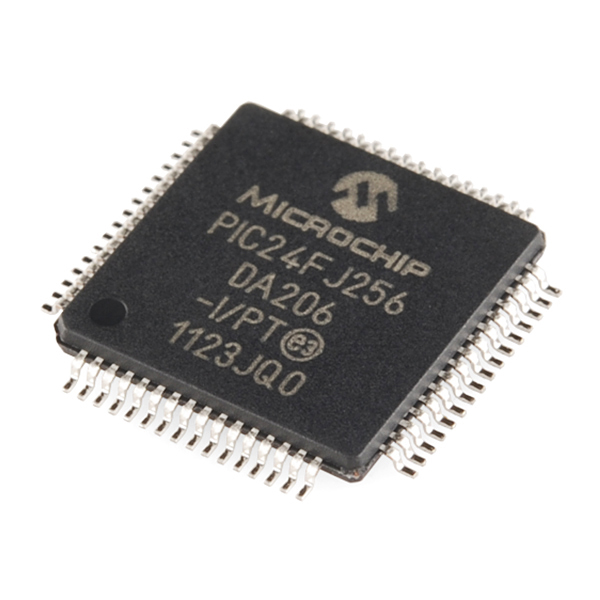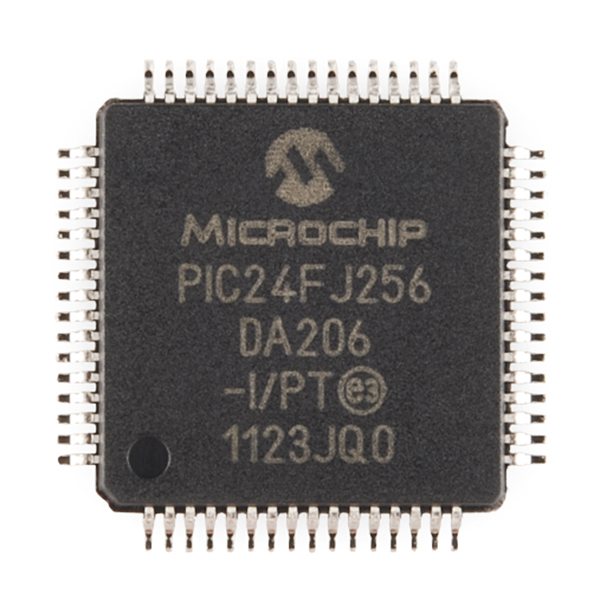PIC24FJ256DA206-I/PT
This is the MCU used for the original IOIO. The PIC24FJ256DA206 is a 16-bit flash microcontroller with an embedded graphics controller and USB On-The-Go (OTG) capabilities.
On-board RAM is provided for display buffer, scratch areas, images and fonts. In some cases, the RAM requirements for the display used exceeds the on-board RAM; external memory connected through EPMP can be used. The embedded graphics module provides acceleration for drawing points, vertical and horizontal lines, rectangles, copying rectangles between different locations on screen, drawing text and decompressing compressed data.
The USB On-The-Go (USB OTG) module provides on-chip functionality as a target device compatible with the USB 2.0 standard, as well as limited stand-alone functionality as a USB embedded host.
- Modified Harvard Architecture
- Up to 16 MIPS Operation at 32 MHz
- 8 MHz Internal Oscillator
- 17-Bit x 17-Bit Single-Cycle Hardware Multiplier
- 32-Bit by 16-Bit Hardware Divider
- 16 x 16-Bit Working Register Array
- On-Chip Voltage Regulator of 1.8V
- Switch between Clock Sources in Real Time
- Idle, Sleep and Doze modes with Fast Wake-up and Two-Speed Start-up
- 10-Bit, up to 24-Channel Analog-to-Digital (A/D) Converter at 500 ksps
- Three Analog Comparators with Programmable Input/Output Configuration
- Operating Voltage Range of 2.2V to 3.6V
- 5.5V Tolerant Input (digital pins only)
- Three Graphics Hardware Accelerators to Facilitate Rendering of Block Copying, Text and Unpacking of Compressed Data
- Color Look-up Table (CLUT) with Maximum of 256 Entries
- 1/2/4/8/16 bits-per-pixel (bpp) Color Depth Set at Run Time
- Display Resolution Programmable According to Frame Buffer
- USB v2.0 On-The-Go (OTG) Compliant
PIC24FJ256DA206-I/PT Product Help and Resources
Core Skill: Soldering
This skill defines how difficult the soldering is on a particular product. It might be a couple simple solder joints, or require special reflow tools.
Skill Level: Competent - You will encounter surface mount components and basic SMD soldering techniques are required.
See all skill levels
Core Skill: Programming
If a board needs code or communicates somehow, you're going to need to know how to program or interface with it. The programming skill is all about communication and code.
Skill Level: Competent - The toolchain for programming is a bit more complex and will examples may not be explicitly provided for you. You will be required to have a fundamental knowledge of programming and be required to provide your own code. You may need to modify existing libraries or code to work with your specific hardware. Sensor and hardware interfaces will be SPI or I2C.
See all skill levels
Core Skill: Electrical Prototyping
If it requires power, you need to know how much, what all the pins do, and how to hook it up. You may need to reference datasheets, schematics, and know the ins and outs of electronics.
Skill Level: Competent - You will be required to reference a datasheet or schematic to know how to use a component. Your knowledge of a datasheet will only require basic features like power requirements, pinouts, or communications type. Also, you may need a power supply that?s greater than 12V or more than 1A worth of current.
See all skill levels
Comments
Looking for answers to technical questions?
We welcome your comments and suggestions below. However, if you are looking for solutions to technical questions please see our Technical Assistance page.
Customer Reviews
No reviews yet.



this name is complicated enough to be the "nerd punchline" of all our jokes.
just imagine:
ay girl, are you from Tennessee? because PIC24FJ256DA206-I/PT.
wow, you must be a computer because you turn my floppy disk into a PIC24FJ256DA206-I/PT.
http://i.imgur.com/kI7bMzf.jpg
this is just the beginning i tell you. it will eventually catch on. eventually.
This is by far my favorite comment of the day.
keep the fire going, dont let it die out my friends
Sometimes I come here to look at how funny I used to be. 7 years passed and it was all downhill. Good times.
I have no idea why you're offering this particular chip. It isn't cheap because of powerful, but not often needed features. Why not offer the more common types (and that cute SOT23 packaged PIC10F200)?
Does it come pre-programmed with the IOIO boot-loader, or should I plan on programming it? I know it's simple enough to use another IOIO and copy it's boot-loader to this chip, but it would be nice if it already had the firmware loaded.
Nope, while it is the chip we used on the original IOIO we don't assume that's what you are going to use it for (and we can't upload code until we have it soldered to a board). In other words its just a blank chip.
Can you soldering on this? What is your suggest for this to attach with the wire ?